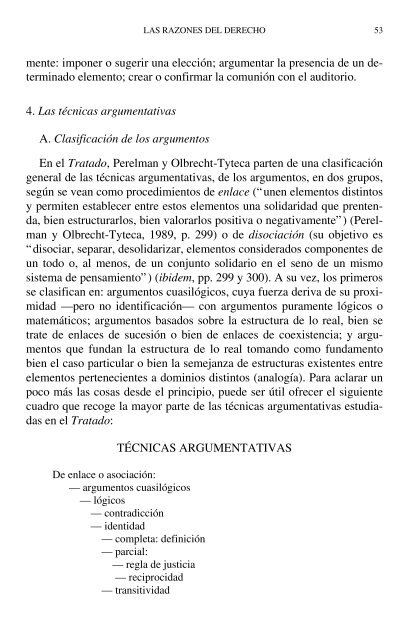LAS RAZONES DEL DERECHO Teo rías de la ar gu men ta ción ju rí di ca
You also want an ePaper? Increase the reach of your titles
YUMPU automatically turns print PDFs into web optimized ePapers that Google loves.
<strong>LAS</strong> <strong>RAZONES</strong> <strong>DEL</strong> <strong>DERECHO</strong> 53<br />
<strong>men</strong>te: imponer o sugerir una elec<strong>ción</strong>; <strong>ar</strong><strong>gu</strong><strong>men</strong>t<strong>ar</strong> <strong>la</strong> presencia <strong>de</strong> un <strong>de</strong>terminado<br />
ele<strong>men</strong>to; cre<strong>ar</strong> o confirm<strong>ar</strong> <strong>la</strong> comunión con el au<strong>di</strong>torio.<br />
4. Las técni<strong>ca</strong>s <strong>ar</strong><strong>gu</strong><strong>men</strong><strong>ta</strong>tivas<br />
A. C<strong>la</strong>sifi<strong>ca</strong><strong>ción</strong> <strong>de</strong> los <strong>ar</strong><strong>gu</strong><strong>men</strong>tos<br />
En el Tra<strong>ta</strong>do, Perelman y Olbrecht-Tyte<strong>ca</strong> p<strong>ar</strong>ten <strong>de</strong> una c<strong>la</strong>sifi<strong>ca</strong><strong>ción</strong><br />
general <strong>de</strong> <strong>la</strong>s técni<strong>ca</strong>s <strong>ar</strong><strong>gu</strong><strong>men</strong><strong>ta</strong>tivas, <strong>de</strong> los <strong>ar</strong><strong>gu</strong><strong>men</strong>tos, en dos grupos,<br />
según se vean como proce<strong>di</strong>mientos <strong>de</strong> en<strong>la</strong>ce (“unen ele<strong>men</strong>tos <strong>di</strong>stintos<br />
y permiten es<strong>ta</strong>blecer entre estos ele<strong>men</strong>tos una solid<strong>ar</strong>idad que prentenda,<br />
bien estructur<strong>ar</strong>los, bien valor<strong>ar</strong>los positiva o negativa<strong>men</strong>te”) (Perelman<br />
y Olbrecht-Tyte<strong>ca</strong>, 1989, p. 299) o <strong>de</strong> <strong>di</strong>socia<strong>ción</strong> (su objetivo es<br />
“<strong>di</strong>soci<strong>ar</strong>, sep<strong>ar</strong><strong>ar</strong>, <strong>de</strong>solid<strong>ar</strong>iz<strong>ar</strong>, ele<strong>men</strong>tos consi<strong>de</strong>rados componentes <strong>de</strong><br />
un todo o, al <strong>men</strong>os, <strong>de</strong> un con<strong>ju</strong>nto solid<strong>ar</strong>io en el seno <strong>de</strong> un mismo<br />
sistema <strong>de</strong> pensamiento”) (ibi<strong>de</strong>m, pp. 299 y 300). A su vez, los primeros<br />
se c<strong>la</strong>sifi<strong>ca</strong>n en: <strong>ar</strong><strong>gu</strong><strong>men</strong>tos cuasilógicos, cuya fuerza <strong>de</strong>riva <strong>de</strong> su proximidad<br />
—pero no i<strong>de</strong>ntifi<strong>ca</strong><strong>ción</strong>— con <strong>ar</strong><strong>gu</strong><strong>men</strong>tos pura<strong>men</strong>te lógicos o<br />
matemáticos; <strong>ar</strong><strong>gu</strong><strong>men</strong>tos basados sobre <strong>la</strong> estructura <strong>de</strong> lo real, bien se<br />
trate <strong>de</strong> en<strong>la</strong>ces <strong>de</strong> sucesión o bien <strong>de</strong> en<strong>la</strong>ces <strong>de</strong> coexistencia; y <strong>ar</strong><strong>gu</strong><strong>men</strong>tos<br />
que fundan <strong>la</strong> estructura <strong>de</strong> lo real tomando como funda<strong>men</strong>to<br />
bien el <strong>ca</strong>so p<strong>ar</strong>ticu<strong>la</strong>r o bien <strong>la</strong> semejanza <strong>de</strong> estructuras existentes entre<br />
ele<strong>men</strong>tos pertenecientes a dominios <strong>di</strong>stintos (analogía). P<strong>ar</strong>a ac<strong>la</strong>r<strong>ar</strong> un<br />
poco más <strong>la</strong>s cosas <strong>de</strong>s<strong>de</strong> el principio, pue<strong>de</strong> ser útil ofrecer el si<strong>gu</strong>iente<br />
cuadro que recoge <strong>la</strong> mayor p<strong>ar</strong>te <strong>de</strong> <strong>la</strong>s técni<strong>ca</strong>s <strong>ar</strong><strong>gu</strong><strong>men</strong><strong>ta</strong>tivas estu<strong>di</strong>adas<br />
en el Tra<strong>ta</strong>do:<br />
TÉCNICAS ARGUMENTATIVAS<br />
De en<strong>la</strong>ce o asocia<strong>ción</strong>:<br />
— <strong>ar</strong><strong>gu</strong><strong>men</strong>tos cuasilógicos<br />
— lógicos<br />
— contra<strong>di</strong>c<strong>ción</strong><br />
— i<strong>de</strong>ntidad<br />
— comple<strong>ta</strong>: <strong>de</strong>fini<strong>ción</strong><br />
— p<strong>ar</strong>cial:<br />
— reg<strong>la</strong> <strong>de</strong> <strong>ju</strong>sticia<br />
— reciprocidad<br />
— transitividad



